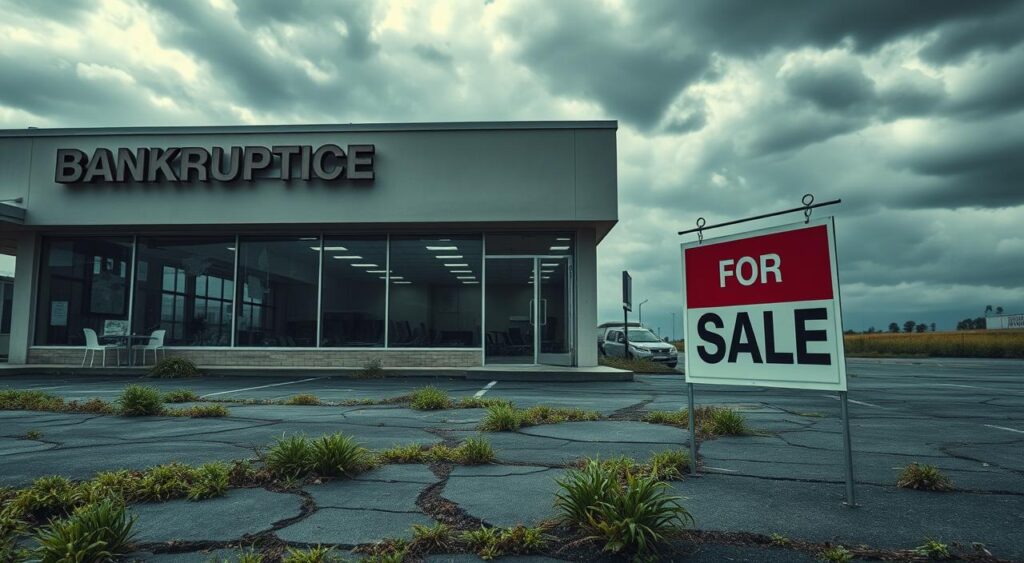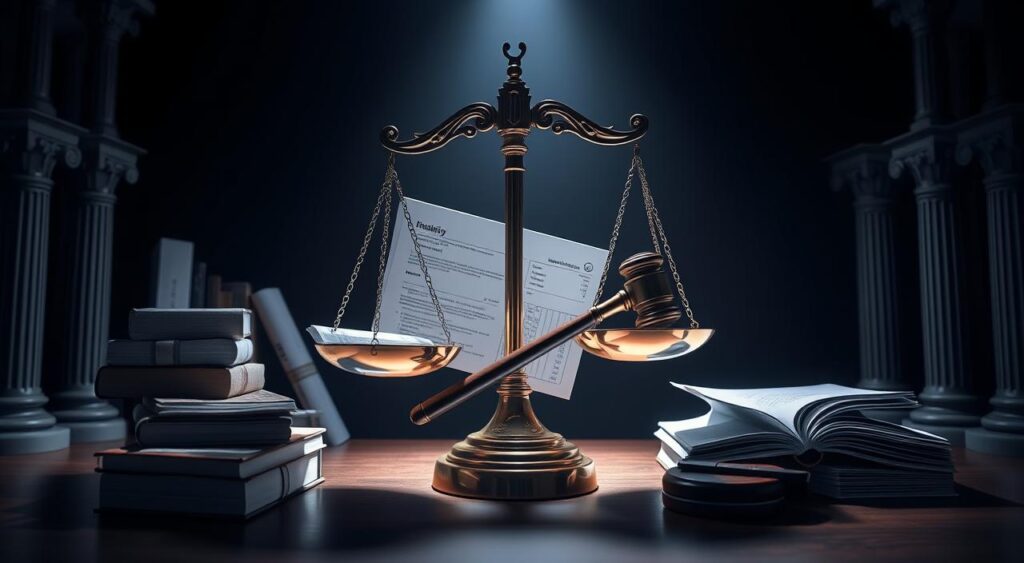What Happens When a Company Declares Bankruptcy: Isku Konkurssiin
Company bankruptcy, or isku konkurssiin, is a complex and challenging process. It affects businesses and individuals deeply. Knowing the basics of bankruptcy is key to understanding these tough situations.
The term isku konkurssiin means a company’s sudden financial collapse. This can happen due to poor management, market changes, or unexpected events. When a company goes bankrupt, it impacts not just the business but also its employees, creditors, and stakeholders.

It’s important for companies and individuals to understand bankruptcy. This knowledge helps make better decisions and take steps to avoid risks. The bankruptcy process includes filing, restructuring, and recovery stages. Knowing these can help companies handle the process better.
Key Takeaways
- Company bankruptcy, or isku konkurssiin, can have significant implications for businesses and individuals.
- Understanding the bankruptcy process is essential for navigating financial distress.
- The term isku konkurssiin refers to the sudden financial collapse of a company.
- Bankruptcy can have far-reaching consequences, affecting employees, creditors, and stakeholders.
- Comprehending the bankruptcy process can help companies make informed decisions and take proactive steps.
- The bankruptcy process involves various stages, from filing to restructuring and recovery.
Understanding Isku Konkurssiin: The Basics of Company Bankruptcy
When a company goes bankrupt, it can seem very complex. It’s key to know the bankruptcy basics. This includes what corporate bankruptcy is and the various types of bankruptcy. This section will cover the basics of company bankruptcy. It aims to make the more complex topics easier to understand.
The bankruptcy process involves important terms like bankruptcy terms. These include insolvency, liquidation, and restructuring. Knowing these terms is vital for making smart choices and getting through the bankruptcy process. In the US, common types are Chapter 7 and Chapter 11. Other countries have similar options.

- Definition of corporate bankruptcy: a company can’t pay its debts
- Types of business bankruptcy: Chapter 7, Chapter 11, and other country-specific equivalents
- Key terms in bankruptcy proceedings: insolvency, liquidation, restructuring, and more
By grasping these bankruptcy basics and types of bankruptcy, people and companies can handle the complex bankruptcy process. They can make informed choices about their financial future.
Initial Steps in the Corporate Bankruptcy Process
The bankruptcy process can be complex and overwhelming for companies facing financial difficulties. When a company considers company bankruptcy, it’s key to know the initial steps. These early actions can greatly affect the outcome of the bankruptcy process.
Companies first assess their financial situation and look for alternatives to company bankruptcy. They might negotiate with creditors, cut expenses, or seek financial help. If bankruptcy seems necessary, they must choose between Chapter 7 or Chapter 11.
Some key initial steps in the bankruptcy process include:
- Conducting a thorough financial analysis to determine the company’s assets, liabilities, and debts
- Consulting with legal and financial experts to determine the best course of action
- Notifying creditors and stakeholders of the company’s intention to file for bankruptcy
Knowing the initial steps in the bankruptcy process helps companies navigate this tough situation. By being proactive and informed, they can reduce risks and work towards recovery.

It’s vital for companies to get professional advice and guidance during the bankruptcy process. This ensures they’re taking the right initial steps towards a successful outcome.
| Step | Description |
|---|---|
| 1. Financial Analysis | Conduct a thorough review of the company’s financial situation |
| 2. Legal Consultation | Seek advice from legal experts to determine the best course of action |
| 3. Notification | Inform creditors and stakeholders of the company’s intention to file for bankruptcy |
Legal Framework and Requirements for Filing Bankruptcy
Knowing the legal rules of bankruptcy is key for those thinking about filing. Bankruptcy laws differ by place, but they all need a deep understanding. Filing for bankruptcy means dealing with many legal requirements and filling out detailed financial forms.
To start, you need to collect important documents like financial statements and tax returns. These are crucial for figuring out if you can file for bankruptcy. The court also plays a big role, making sure everyone follows the bankruptcy laws and rules.
Key Aspects of the Bankruptcy Process
- Required documentation, including financial statements and tax returns
- Court procedures, such as filing petitions and attending hearings
- Timeline expectations, including deadlines for submitting documentation and completing the bankruptcy process
Knowing these parts of the bankruptcy process helps individuals and businesses. It’s important to talk to a skilled lawyer. They can help make sure you follow all bankruptcy laws and get the best outcome.

Timeline Expectations
| Stage | Timeline |
|---|---|
| Filing Petition | Immediate |
| Court Review | 2-4 weeks |
| Creditor Meeting | 4-6 weeks |
| Discharge | 3-6 months |
Impact on Company Assets and Property
When a company goes bankrupt, its company assets take a big hit. Bankruptcy and assets are closely tied, as assets are often used to settle debts. The property in bankruptcy can include real estate, equipment, and other tangible items.
The effects of bankruptcy on company assets can be harsh. Sometimes, the company must sell off its assets to pay creditors. This can mean selling property in bankruptcy like buildings, land, or equipment. But, some assets might be safe from being sold, like key business equipment or property needed for operations.
Here are some key points to consider regarding the impact of bankruptcy on company assets:
- Asset liquidation: The company may be required to sell off its assets to pay off debts.
- Asset protection: Some assets may be protected from liquidation, such as essential business equipment or property.
- Bankruptcy and assets: The company’s assets are closely linked to its bankruptcy, as they are often used to pay off debts.

In conclusion, bankruptcy can have a big impact on a company’s assets and property. It’s crucial for companies to grasp how bankruptcy and assets are connected. They should also take steps to safeguard their assets during bankruptcy.
| Asset Type | Impact of Bankruptcy |
|---|---|
| Real Estate | May be sold off to pay off debts |
| Equipment | May be protected from liquidation if essential to business operations |
| Intangible Assets | May be affected by bankruptcy, but impact varies depending on asset type |
Effects on Employees During Bankruptcy Proceedings
When a company goes bankrupt, it’s tough for employees. It’s important to know about employee rights and how bankruptcy and employees affect them. Employees have rights to ensure they’re treated fairly.
Key things to think about include wage claims and benefits, and job transition help. Employees might get unpaid wages and benefits. Companies must also help with job transition, like outplacement services or career advice.

- Employee rights and protections under bankruptcy law
- Wage claims and benefits entitlement
- Job transition support and outplacement services
It’s vital for employees to know their rights and the help available. By understanding bankruptcy and employees, they can handle the situation better. This includes planning for their future, like finding new jobs.
| Employee Rights | Bankruptcy and Employees | Job Transition Support |
|---|---|---|
| Wage claims and benefits | Protection under bankruptcy law | Outplacement services |
| Job security | Impact on employee benefits | Career counseling |
Creditor Relations and Debt Management
When a company goes through bankruptcy, it’s key to keep creditor relations positive. This helps the company’s reputation and future success. Good debt management is vital for dealing with creditors and their expectations.
Being open and clear with creditors is important. Companies need to tell all creditors about the bankruptcy and how they plan to handle debts. Regular updates and open lines of communication help a lot.
- Renegotiating payment terms with creditors
- Consolidating debts into a single, manageable payment
- Seeking professional advice from a financial advisor or attorney
By focusing on creditor relations and using smart debt management plans, companies can get through bankruptcy successfully. They can come out stronger on the other side.
Business Operations During Bankruptcy
When a company files for bankruptcy, it’s key to know how it runs during this time. The aim is to guide readers on managing daily tasks, keeping customer and supplier relations strong. Studies show that companies can keep running, but under court watch.
Keeping things running smoothly is vital. This means handling everyday tasks like payroll and customer service. It’s also important to keep good relations with customers and suppliers. This way, businesses can keep things moving and keep their relationships intact.
- Managing cash flow to ensure continuity of operations
- Communicating with stakeholders, including customers, suppliers, and employees
- Identifying areas for cost reduction and implementing efficiency measures
By focusing on these key areas, companies can get through bankruptcy. It’s important to remember that a business can still operate during bankruptcy. With the right management, companies can come out stronger and more resilient.
Alternatives to Complete Bankruptcy
When a company is in financial trouble, alternatives to bankruptcy can help. Debt restructuring and financial recovery plans can steer companies away from bankruptcy’s downsides. These options give businesses a chance to start anew and become profitable once more.
Some common alternatives to bankruptcy include:
- Debt restructuring: This involves negotiating with creditors to reduce debt or extend payment terms.
- Workouts: This is an informal agreement between the company and its creditors to restructure debt.
- Financial recovery plans: These plans involve creating a strategy to become profitable again, such as reducing costs or increasing revenue.
These alternatives are good for companies facing financial issues but still have a solid business plan. By looking into alternatives to bankruptcy, companies can dodge bankruptcy’s stigma and financial hits. Instead, they can focus on debt restructuring and financial recovery.
A company thinking about alternatives to bankruptcy should talk to a financial advisor. They can help craft a plan to get back on track and avoid bankruptcy.
In some cases, companies can negotiate with creditors to lower debt or stretch out payments. This can help avoid bankruptcy. It’s a complex process, but with the right advice, companies can find a solution. By exploring alternatives to bankruptcy, companies can start their journey towards financial recovery and a better future.
Companies that are proactive and seek help early on are more likely to find a successful alternative to bankruptcy.
| Alternative | Description |
|---|---|
| Debt Restructuring | Negotiating with creditors to reduce debt or extend payment terms |
| Workouts | Informal agreement between the company and its creditors to restructure debt |
| Financial Recovery Plans | Creating a strategy to become profitable again, such as reducing costs or increasing revenue |
Recovery and Restructuring Options
When a company is in financial trouble, finding ways to recover is key. Debt reorganization is a powerful tool. It lets companies renegotiate debts to make payments easier.
Some important steps for recovery and restructuring include:
- Looking at the company’s finances to find areas to improve
- Creating a detailed plan for debt reorganization and restructuring
- Making changes to the business model to save money and work better
- Changing the financial strategy to last in the long run
By trying these recovery options and restructuring strategies, companies can fight back.
| Recovery Option | Description |
|---|---|
| Debt Reorganization | Renegotiating debts with creditors to create a more manageable payment plan |
| Business Model Adjustments | Implementing changes to increase efficiency and reduce costs |
| Financial Strategy Overhaul | Developing a new financial strategy to ensure long-term sustainability |
Prevention Strategies and Early Warning Signs
Spotting early warning signs of financial trouble is key to avoiding bankruptcy. Companies can stay ahead by keeping an eye on their financial health. This means checking financial reports, controlling debt, and keeping cash flow steady.
To dodge bankruptcy, companies should:
- Keep a close eye on their finances
- Spot and tackle potential problems
- Have a plan ready for tough times
Knowing the early warning signs of financial trouble, like falling sales or growing debt, helps companies act fast. They might get advice from experts, talk about debt changes, or look for new funding. This keeps their financial health strong.
Good bankruptcy prevention plans need a deep understanding of a company’s finances. Being proactive in managing risks is essential. By focusing on financial health and catching early warning signs, companies can avoid bankruptcy and stay stable for the long haul.
Conclusion: Moving Forward After Bankruptcy
Bankruptcy can be tough and stressful, but it’s also a chance to start over and get back on track financially. The post-bankruptcy time is key for both companies and people wanting to move forward and get back on their feet. By learning from past mistakes and making smart plans, businesses can come out of bankruptcy stronger and more ready to face challenges.
The first step in getting better is to deal with any leftover debts and work with creditors to get better payment terms. This might mean making new plans for debt, selling off assets, or changing payment schedules. At the same time, companies need to work on fixing their credit scores. This takes time but is important to get back the trust of lenders and investors.
Companies should also think about changing their business models and how they operate to avoid future money problems. This could mean finding new ways to make money, cutting costs, and managing risks better. By making these changes, businesses can set themselves up for success and growth after bankruptcy.
FAQ
What is the definition of corporate bankruptcy?
Corporate bankruptcy is when a company says it can’t pay its debts. It involves selling or reorganizing assets to pay creditors.
What are the different types of business bankruptcy?
There are two main types: Chapter 7 and Chapter 11. Chapter 7 means selling assets to pay creditors. Chapter 11 lets the company reorganize and keep running.
What are some key terms in bankruptcy proceedings?
Important terms include creditor, debtor, and bankruptcy estate. Also, automatic stay, discharge, and reorganization plan are key. Knowing these terms helps understand bankruptcy.
What are the initial steps a company takes when facing bankruptcy?
First, a company checks its finances and talks to stakeholders. It might look at debt restructuring or selling assets. It also starts gathering documents for bankruptcy.
What are the legal requirements for filing for bankruptcy?
To file for bankruptcy, a company must provide financial records and list all assets and debts. It must follow court rules. The process’s length varies based on the case’s complexity and location.
How does bankruptcy affect a company’s assets and property?
Bankruptcy can change a company’s assets and property a lot. Some assets might be sold to pay creditors. Others could be kept or reorganized. The outcome depends on the bankruptcy type and laws.
What are the rights and protections for employees during bankruptcy proceedings?
Employees have rights during bankruptcy. They can file wage claims and keep benefits. Laws try to protect their jobs and interests.
How do creditors interact with the company during bankruptcy?
Creditors are key in bankruptcy. They get notified, attend meetings, and help find debt solutions. The goal is to benefit both the company and creditors.
How are day-to-day business operations managed during bankruptcy?
Companies usually keep running during bankruptcy. They manage customer and supplier relations. This helps keep the business going.
What alternatives to complete bankruptcy are available?
Companies can explore options like debt restructuring or workouts. These alternatives can help avoid bankruptcy’s harsh effects while solving financial issues.
